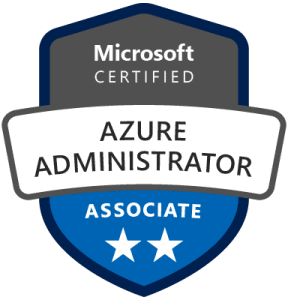This certification track comes with the following benefits:
- Digital Courseware
- Practice Labs
- 30-Day Azure Pass
- Free Practice Exam
- Free Exam Voucher
- Mentoring
Identity
In this module, you will learn how to secure identities with Azure Active Directory, and implement users and groups.
- Azure Active Directory
- Users and Groups
Lab: Manage Azure Active Directory Identities
After completing this module, students will be able to:
- Secure and manage identities with Azure Active Directory
- Implement and manage users and groups
Governance and Compliance
In this module, you will learn about managing your subscriptions and accounts, implementing Azure policies, and using Role-Based Access Control.
- Subscriptions and Accounts
- Azure Policy
- Role-based Access Control (RBAC)
Lab: Manage Subscriptions and RBAC
Lab: Manage Governance via Azure Policy
After completing this module, students will be able to:
- Implement and manage Azure subscriptions and accounts
- Implement Azure Policy, including custom policies
- Use RBAC to assign permissions
Azure Administration
In this module, you will learn about the tools an Azure Administrator uses to manage their infrastructure. This includes the Azure Portal, Cloud Shell, Azure PowerShell, CLI, and Resource Manager Templates.
- Azure Administrator Tools
- ARM Templates
Lab: Manage Azure resources by Using the Azure Portal
Lab: Manage Azure resources by Using ARM Templates
Lab: Manage Azure resources by Using Azure PowerShell (optional)
Lab: Manage Azure resources by Using Azure CLI (optional)
After completing this module, students will be able to:
- Use the Azure Portal and Cloud Shell
- Use Azure PowerShell and CLI
- Use ARM Templates to deploy resources
Virtual Networking
In this module, you will learn about basic virtual networking concepts like virtual networks and subnetting, IP addressing, network security groups, Azure Firewall, and Azure DNS.
- Virtual Networks
- Network Security groups
- Azure Firewall
- Azure DNS
Lab: Implement Virtual Networking
After completing this module, students will be able to:
- Implement virtual networks and subnets
- Configure network security groups.
- Configure Azure Firewall
- Configure private and public DNS zones
Intersite Connectivity
In this module, you will learn about intersite connectivity features including VNet Peering, Virtual Network Gateways, and Site-to-Site Connections.
- VNet Peering
- VPN Gateway Connections
- ExpressRoute and Virtual WAN
Lab: Implement Intersite Connectivity
After completing this module, students will be able to:
- Configure VNet Peering.
- Configure VPN gateways.
- Choose the appropriate intersite connectivity solution.
Network Traffic Management
In this module, you will learn about network traffic strategies including network routing and service endpoints, Azure Load Balancer, and Azure Application Gateway.
- Network Routing and Endpoints
- Azure Load Balancer
- Azure Application Gateway
- Network Watcher
Lab: Implement Traffic Management
After completing this module, students will be able to:
- Configure network routing including custom routes and service endpoints
- Configure an Azure Load Balancer.
- Configure an Azure Application Gateway
- Configure Network Watcher
Azure Storage
In this module, you will learn about basic storage features including storage accounts, blob storage, Azure files and File Sync, storage security, and storage tools.
- Storage Accounts
- Blob Storage
- Storage Security
- Azure Files and File Sync
- Managing Storage
Lab: Manage Azure storage
After completing this module, students will be able to:
- Create Azure storage accounts
- Configure blob containers
- Secure Azure storage
- Configure Azure files shares and file sync
- Manage storage with tools such as Storage Explorer
Azure Virtual Machines
In this module, you will learn about Azure virtual machines including planning, creating, availability and extensions.
- Creating Virtual Machines
- Virtual Machine Availability
- Virtual Machine Extensions
Lab: Manage virtual machines
After completing this module, students will be able to:
- Plan for virtual machine implementations
- Create virtual machines
- Configure virtual machine availability, including scale sets
- Use virtual machine extensions
PaaS Compute Options
In this module, you will learn how to administer serverless computing features like Azure App Service, Azure Container Instances, and Kubernetes.
- Azure App Service Plans
- Azure App Service
- Container Services
- Azure Kubernetes Service
Lab: Implement Web AppsLab : Implement Azure Container Instances
Lab: Implement Azure Kubernetes Service
After completing this module, students will be able to:
- Create an app service plan
- Create a web app
- Implement Azure Container Instances
- Implement Azure Kubernetes Service
Data Protection
In this module, you will learn about backing up files and folders, and virtual machine backups.
- File and Folder Backups
- Virtual Machine Backups
Lab: Implement Data ProtectionAfter completing this module, students will be able to:
- Backup and restore file and folders
- Backup and restore virtual machines
Monitoring
In this module, you will learn about monitoring your Azure infrastructure including Azure Monitor, alerting, and log analytics.
- Azure Monitor
- Azure Alerts
- Log Analytics
Lab: Implement Monitoring
After completing this module, students will be able to:
- Use Azure Monitor
- Create Azure alerts
- Query using Log Analytics
